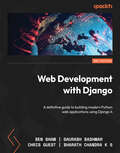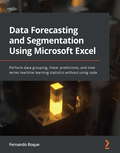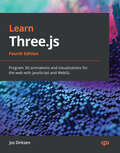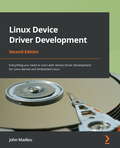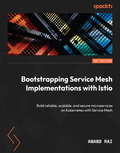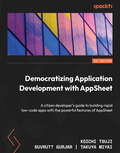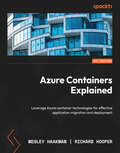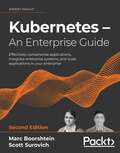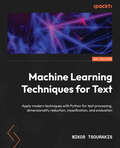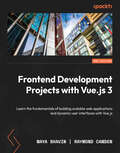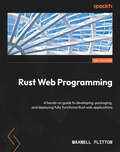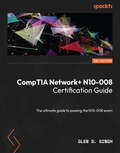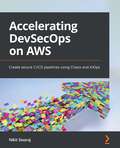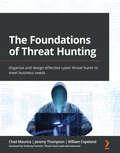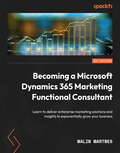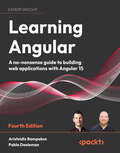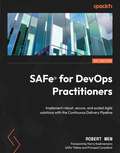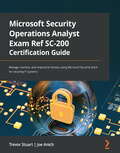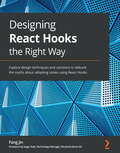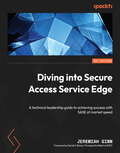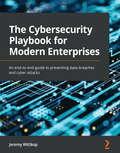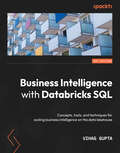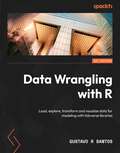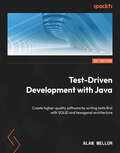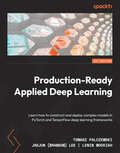- Table View
- List View
Web Development with Django: A definitive guide to building modern Python web applications using Django 4, 2nd Edition
by Ben Shaw Saurabh Badhwar Chris Guest Bharath Chandra SWork through realistic case studies to create your own websites easily, securely, and quicklyPurchase of the print or Kindle book includes a free PDF eBookKey FeaturesUnderstand Django functionality and the Model-View-Template (MVT) paradigmCreate and iteratively build a book review website, adding features as you build your knowledgeExplore advanced concepts such as REST API implementation and third-party module integrationBook DescriptionDo you want to develop reliable and secure applications that stand out from the crowd without spending hours on boilerplate code? You've made the right choice trusting the Django framework, and this book will tell you why. Often referred to as a “batteries included” web development framework, Django comes with all the core features needed to build a standalone application. Web Development with Django will take you through all the essential concepts and help you explore its power to build real-world applications using Python. Throughout the book, you'll get the grips with the major features of Django by building a website called Bookr – a repository for book reviews. This end-to-end case study is split into a series of bitesize projects presented as exercises and activities, allowing you to challenge yourself in an enjoyable and attainable way. As you advance, you'll acquire various practical skills, including how to serve static files to add CSS, JavaScript, and images to your application, how to implement forms to accept user input, and how to manage sessions to ensure a reliable user experience. You'll cover everyday tasks that are part of the development cycle of a real-world web application. By the end of this Django book, you'll have the skills and confidence to creatively develop and deploy your own projects.What you will learnCreate a new application and add models to describe your dataUse views and templates to control behavior and appearanceImplement access control through authentication and permissionsDevelop practical web forms to add features such as file uploadsBuild a RESTful API and JavaScript code that communicates with itConnect to a database such as PostgreSQLWho this book is forThis book is for programmers looking to enhance their web development skills using the Django framework. To fully understand the concepts explained in this book, basic knowledge of Python programming as well as familiarity with JavaScript, HTML, and CSS is assumed.
Data Forecasting and Segmentation Using Microsoft Excel: Perform data grouping, linear predictions, and time series machine learning statistics without using code
by Fernando RoquePerform time series forecasts, linear prediction, and data segmentation with no-code Excel machine learningKey FeaturesSegment data, regression predictions, and time series forecasts without writing any codeGroup multiple variables with K-means using Excel plugin without programmingBuild, validate, and predict with a multiple linear regression model and time series forecastsBook DescriptionData Forecasting and Segmentation Using Microsoft Excel guides you through basic statistics to test whether your data can be used to perform regression predictions and time series forecasts. The exercises covered in this book use real-life data from Kaggle, such as demand for seasonal air tickets and credit card fraud detection.You'll learn how to apply the grouping K-means algorithm, which helps you find segments of your data that are impossible to see with other analyses, such as business intelligence (BI) and pivot analysis. By analyzing groups returned by K-means, you'll be able to detect outliers that could indicate possible fraud or a bad function in network packets.By the end of this Microsoft Excel book, you'll be able to use the classification algorithm to group data with different variables. You'll also be able to train linear and time series models to perform predictions and forecasts based on past data.What you will learnUnderstand why machine learning is important for classifying data segmentationFocus on basic statistics tests for regression variable dependencyTest time series autocorrelation to build a useful forecastUse Excel add-ins to run K-means without programmingAnalyze segment outliers for possible data anomalies and fraudBuild, train, and validate multiple regression models and time series forecastsWho this book is forThis book is for data and business analysts as well as data science professionals. MIS, finance, and auditing professionals working with MS Excel will also find this book beneficial.
Learn Three.js: Program 3D animations and visualizations for the web with JavaScript and WebGL, 4th Edition
by Jos DirksenBecome a creative JavaScript professional by creating and animating stunning 3D, browser-based graphics with Three.js from beginning to endPurchase of the print or Kindle book includes a free eBook in PDF formatKey FeaturesEnhance your 3D graphics with light sources, shadows, advanced materials, and texturesLoad models from external sources, visualize and, animate them directly using JavaScriptCreate your own custom WebGL shader, explore Three.js' postprocessing feature, and learn how to integrate with Blender, React, and TypescriptBook DescriptionThree.js has become the industry standard for creating stunning 3D WebGL content. In this edition, you'll learn about all the features of Three.js and understand how to integrate it with the newest physics engines. You'll also develop a strong grip on creating and animating immersive 3D scenes directly in your browser, reaping the full potential of WebGL and modern browsers. The book starts with the basic concepts and building blocks used in Three.js and helps you explore these essential topics in detail through extensive examples and code samples. You'll learn how to create realistic-looking 3D objects using textures and materials and how to load existing models from an external source. Next, you'll understand how to control the camera using the Three.js built-in camera controls, which will enable you to fly or walk around the 3D scene you've created. Later chapters will cover the use of HTML5 video and canvas elements as materials for your 3D objects to animate your models. You'll learn how to use morph targets and skeleton-based animation, before understanding how to add physics, such as gravity and collision detection, to your scene. Finally, you'll master combining Blender with Three.js and creating VR and AR scenes. By the end of this book, you'll be well-equipped to create 3D-animated graphics using Three.js.What you will learnImplement the different camera controls provided by Three.js to navigate your 3D sceneDiscover working with vertices directly to create snow, rain, and galaxy-like effectsImport and animate models from external formats, such as glTF, OBJ, STL, and COLLADADesign and run animations using morph targets and bone-based animationCreate realistic-looking 3D objects using advanced textures on materialsInteract directly with WebGL by creating custom vertex and fragment shadersMake scenes using the Rapier physics engine, and integrate Three.js with VR and ARWho this book is forThis book is for JavaScript developers looking to learn the use of Three.js library.
Linux Device Driver Development: Everything you need to start with device driver development for Linux kernel and embedded Linux, 2nd Edition
by John MadieuGet up to speed with the most important concepts in driver development and focus on common embedded system requirements such as memory management, interrupt management, and locking mechanismsKey FeaturesWrite feature-rich and customized Linux device drivers for any character, SPI, and I2C deviceDevelop a deep understanding of locking primitives, IRQ management, memory management, DMA, and so onGain practical experience in the embedded side of Linux using GPIO, IIO, and input subsystemsBook DescriptionLinux is by far the most-used kernel on embedded systems. Thanks to its subsystems, the Linux kernel supports almost all of the application fields in the industrial world. This updated second edition of Linux Device Driver Development is a comprehensive introduction to the Linux kernel world and the different subsystems that it is made of, and will be useful for embedded developers from any discipline.You'll learn how to configure, tailor, and build the Linux kernel. Filled with real-world examples, the book covers each of the most-used subsystems in the embedded domains such as GPIO, direct memory access, interrupt management, and I2C/SPI device drivers. This book will show you how Linux abstracts each device from a hardware point of view and how a device is bound to its driver(s). You'll also see how interrupts are propagated in the system as the book covers the interrupt processing mechanisms in-depth and describes every kernel structure and API involved. This new edition also addresses how not to write device drivers using user space libraries for GPIO clients, I2C, and SPI drivers.By the end of this Linux book, you'll be able to write device drivers for most of the embedded devices out there. What you will learnDownload, configure, build, and tailor the Linux kernelDescribe the hardware using a device treeWrite feature-rich platform drivers and leverage I2C and SPI busesGet the most out of the new concurrency managed workqueue infrastructureUnderstand the Linux kernel timekeeping mechanism and use time-related APIsUse the regmap framework to factor the code and make it genericOffload CPU for memory copies using DMAInteract with the real world using GPIO, IIO, and input subsystemsWho this book is forThis Linux OS book is for embedded system and embedded Linux enthusiasts/developers who want to get started with Linux kernel development and leverage its subsystems. Electronic hackers and hobbyists interested in Linux kernel development as well as anyone looking to interact with the platform using GPIO, IIO, and input subsystems will also find this book useful.
Bootstrapping Service Mesh Implementations with Istio: Build reliable, scalable, and secure microservices on Kubernetes with Service Mesh
by Anand RaiA step-by-step guide to Istio Service Mesh implementation, with examples of complex and distributed workloads built using microservices architecture and deployed in KubernetesPurchase of the print or Kindle book includes a free PDF eBookKey FeaturesLearn the design, implementation, and troubleshooting of Istio in a clear and concise formatGrasp concepts, ideas, and solutions that can be readily applied in real work environmentsSee Istio in action through examples that cover Terraform, GitOps, AWS, Kubernetes, and GoBook DescriptionIstio is a game-changer in managing connectivity and operational efficiency of microservices, but implementing and using it in applications can be challenging. This book will help you overcome these challenges and gain insights into Istio's features and functionality layer by layer with the help of easy-to-follow examples. It will let you focus on implementing and deploying Istio on the cloud and in production environments instead of dealing with the complexity of demo apps.You'll learn the installation, architecture, and components of Istio Service Mesh, perform multi-cluster installation, and integrate legacy workloads deployed on virtual machines. As you advance, you'll understand how to secure microservices from threats, perform multi-cluster deployments on Kubernetes, use load balancing, monitor application traffic, implement service discovery and management, and much more. You'll also explore other Service Mesh technologies such as Linkerd, Consul, Kuma, and Gloo Mesh. In addition to observing and operating Istio using Kiali, Prometheus, Grafana and Jaeger, you'll perform zero-trust security and reliable communication between distributed applications.After reading this book, you'll be equipped with the practical knowledge and skills needed to use and operate Istio effectively.What you will learnGet an overview of Service Mesh and the problems it solvesBecome well-versed with the fundamentals of Istio, its architecture, installation, and deploymentExtend the Istio data plane using WebAssembly (Wasm) and learn why Envoy is used as a data planeUnderstand how to use OPA Gatekeeper to automate Istio's best practicesManage communication between microservices using IstioExplore different ways to secure the communication between microservicesGet insights into traffic flow in the Service MeshLearn best practices to deploy and operate Istio in production environmentsWho this book is forThe book is for DevOps engineers, SREs, cloud and software developers, sysadmins, and architects who have been using microservices in Kubernetes-based environments. It addresses challenges in application networking during microservice communications. Working experience on Kubernetes, along with knowledge of DevOps, application networking, security, and programming languages like Golang, will assist with understanding the concepts covered.
Democratizing Application Development with AppSheet: A citizen developer's guide to building rapid low-code apps with the powerful features of AppSheet
by Koichi Tsuji Suvrutt Gurjar Takuya MiyaiA hands-on guide to building sophisticated business applications and automation using AppSheet to deliver business results quickly without writing lines of codeKey FeaturesLearn how the AppSheet Editor works to configure, test, and deploy a business app without writing lines of codeGet hands-on experience with AppSheet by building a real-world application throughout the bookExplore useful tips and tricks to develop custom functionalities in the app to meet unique business needsBook DescriptionMany citizen developers regularly use spreadsheets in their business and day-to-day jobs. With AppSheet, you can take your spreadsheets to the next level by enhancing their ease of use. The platform allows you to run your business efficiently and manage it in the field outside of an office or indoor environment. This book enables you to create your own simple or medium to complex hybrid apps for business or personal use.As a beginner to AppSheet, this book will show you how the AppSheet Editor works and how it is used to configure, test, and deploy an app and share it with others as users or co-authors. You'll learn about widely used features such as how to use data sources, create app views and actions, construct expressions with AppSheet functions, and make your app secure through security and UX options. Next, you'll create email/attachment templates and develop reports/documents based on templates, store in the cloud, and send files through emails. You'll also understand how to integrate third-party services and monitor various usage statistics of your app. As you progress, you'll explore various features with the help of sample apps that you create using the book.By the end of this book, you'll have learned how to make the most of AppSheet to build powerful and efficient applications.What you will learnDiscover how the AppSheet app is presented for app usersExplore the different views you can use and how to format your data with colors and iconsUnderstand AppSheet functions such as yes/no, text, math, list, date and time and build expressions with those functionsExplore different actions such as data change, app navigation, external communication, and CSV import/exportAdd/delete and define editing permissions and learn to broadcast notifications and inform users of changesBuild a bot through the AppSheet Automation feature to automate various business workflowsWho this book is forThis book is for beginner and intermediate-level citizen application developers in small or medium size businesses and business users who want to develop their own apps. Basic knowledge of Google Sheets or Excel and an understanding of different spreadsheet formulas are required. Knowledge of SQL and basic software development will be beneficial but not necessary.
Azure Containers Explained: Leverage Azure container technologies for effective application migration and deployment
by Wesley Haakman Richard HooperApply scenario-based learning to effectively handle the technical and business impact of various services like AKS, ACI, Azure Functions, and Azure Container Apps on AzurePurchase of the print or Kindle book includes a free PDF eBookKey FeaturesUnderstand the what, why, and how of different container technologies available on Microsoft AzureExplore the practical implementation of various Azure container technologies with the help of use casesLearn common business strategies for selecting the right Azure container technology at optimized costBook DescriptionWhether you're working with a start-up or an enterprise, making decisions related to using different container technologies on Azure has a notable impact your app migration and modernization strategies. This is where companies face challenges, while choosing the right solutions and deciding when to move on to the next technology. Azure Containers Explained helps you make the right architectural choices for your solutions and get well-versed with the migration path to other platforms using practical examples.You'll begin with a recap of containers as technology and where you can store them within Azure. Next, you'll explore the different Microsoft Azure container technologies and understand how each platform, namely Azure Container Apps, Azure Kubernetes Service (AKS), Azure Container Instances (ACI), Azure Functions, and Azure App Services, work – you'll learn to implement them by grasping their respective characteristics and use cases. Finally, you'll build upon your own container solution on Azure using best practices from real-world examples and successfully transform your business from a start-up to a full-fledged enterprise.By the end of this book, you'll be able to effectively cater to your business and application needs by selecting and modernizing your apps using various Microsoft Azure container services.What you will learnMake the best-suited architectural choices to meet your business and application needsUnderstand the migration paths between different Azure Container servicesDeploy containerized applications on Azure to multiple technologiesKnow when to use Azure Container Apps versus Azure Kubernetes ServiceFind out how to add features to an AKS clusterInvestigate the containers on Azure Web apps and Functions appsDiscover ways to improve your current architecture without starting againExplore the financial implications of using Azure container servicesWho this book is forThis book is for cloud and DevOps architects, application developers, technical leaders, decision makers, and IT professionals working with Microsoft Azure and cloud native technologies, especially containers. Reasonable knowledge of containers and a solid understanding of Microsoft Azure will help you grasp the concepts in this book.
Kubernetes – An Enterprise Guide: Effectively containerize applications, integrate enterprise systems, and scale applications in your enterprise, 2nd Edition
by Scott Surovich Marc BoorshteinMaster core Kubernetes concepts important to enterprises from security, policy, and management point-of-view. Learn to deploy a service mesh using Istio, build a CI/CD platform, and provide enterprise security to your clusters.Key FeaturesExtensively revised edition to cover the latest updates and new releases along with two new chapters to introduce IstioGet a firm command of Kubernetes from a dual perspective of an admin as well as a developerUnderstand advanced topics including load balancing, externalDNS, global load balancing, authentication integration, policy, security, auditing, backup, Istio and CI/CDBook DescriptionKubernetes has taken the world by storm, becoming the standard infrastructure for DevOps teams to develop, test, and run applications. With significant updates in each chapter, this revised edition will help you acquire the knowledge and tools required to integrate Kubernetes clusters in an enterprise environment.The book introduces you to Docker and Kubernetes fundamentals, including a review of basic Kubernetes objects. You'll get to grips with containerization and understand its core functionalities such as creating ephemeral multinode clusters using KinD. The book has replaced PodSecurityPolicies (PSP) with OPA/Gatekeeper for PSP-like enforcement. You'll integrate your container into a cloud platform and tools including MetalLB, externalDNS, OpenID connect (OIDC), Open Policy Agent (OPA), Falco, and Velero. After learning to deploy your core cluster, you'll learn how to deploy Istio and how to deploy both monolithic applications and microservices into your service mesh. Finally, you will discover how to deploy an entire GitOps platform to Kubernetes using continuous integration and continuous delivery (CI/CD).What you will learnCreate a multinode Kubernetes cluster using KinDImplement Ingress, MetalLB, ExternalDNS, and the new sandbox project, K8GBConfigure a cluster OIDC and impersonationDeploy a monolithic application in Istio service meshMap enterprise authorization to KubernetesSecure clusters using OPA and GateKeeperEnhance auditing using Falco and ECKBack up your workload for disaster recovery and cluster migrationDeploy to a GitOps platform using Tekton, GitLab, and ArgoCDWho this book is forThis book is for anyone interested in DevOps, containerization, and going beyond basic Kubernetes cluster deployments. DevOps engineers, developers, and system administrators looking to enhance their IT career paths will also find this book helpful.Although some prior experience with Docker and Kubernetes is recommended, this book includes a Kubernetes bootcamp that provides a description of Kubernetes objects to help you if you are new to the topic or need a refresher.
Machine Learning Techniques for Text: Apply modern techniques with Python for text processing, dimensionality reduction, classification, and evaluation
by Nikos TsourakisTake your Python text processing skills to another level by learning about the latest natural language processing and machine learning techniques with this full color guideKey FeaturesLearn how to acquire and process textual data and visualize the key findingsObtain deeper insight into the most commonly used algorithms and techniques and understand their tradeoffsImplement models for solving real-world problems and evaluate their performanceBook DescriptionWith the ever-increasing demand for machine learning and programming professionals, it's prime time to invest in the field. This book will help you in this endeavor, focusing specifically on text data and human language by steering a middle path among the various textbooks that present complicated theoretical concepts or focus disproportionately on Python code.A good metaphor this work builds upon is the relationship between an experienced craftsperson and their trainee. Based on the current problem, the former picks a tool from the toolbox, explains its utility, and puts it into action. This approach will help you to identify at least one practical use for each method or technique presented. The content unfolds in ten chapters, each discussing one specific case study. For this reason, the book is solution-oriented. It's accompanied by Python code in the form of Jupyter notebooks to help you obtain hands-on experience. A recurring pattern in the chapters of this book is helping you get some intuition on the data and then implement and contrast various solutions.By the end of this book, you'll be able to understand and apply various techniques with Python for text preprocessing, text representation, dimensionality reduction, machine learning, language modeling, visualization, and evaluation.What you will learnUnderstand fundamental concepts of machine learning for textDiscover how text data can be represented and build language modelsPerform exploratory data analysis on text corporaUse text preprocessing techniques and understand their trade-offsApply dimensionality reduction for visualization and classificationIncorporate and fine-tune algorithms and models for machine learningEvaluate the performance of the implemented systemsKnow the tools for retrieving text data and visualizing the machine learning workflowWho this book is forThis book is for professionals in the area of computer science, programming, data science, informatics, business analytics, statistics, language technology, and more who aim for a gentle career shift in machine learning for text. Students in relevant disciplines that seek a textbook in the field will benefit from the practical aspects of the content and how the theory is presented. Finally, professors teaching a similar course will be able to pick pertinent topics in terms of content and difficulty. Beginner-level knowledge of Python programming is needed to get started with this book.
Frontend Development Projects with Vue.js 3: Learn the fundamentals of building scalable web applications and dynamic user interfaces with Vue.js, 2nd Edition
by Raymond Camden Maya ShavinLet industry experts guide you on your journey to becoming a Vue.js developer with the help of practical projects and fun exercisesPurchase of the print or Kindle book includes a free PDF eBookKey FeaturesWork through mini projects, exercises, and activities to learn Vue.js in a practical wayCreate dynamic components and user interfaces that are fast and intuitiveFind out how you can get the most out of the Vue.js 3 framework and build an end-to-end projectBook DescriptionAre you looking to use Vue.js 3 for building web apps but don't know where to begin?Frontend Development Projects with Vue.js 3 will help you get to grips with the core concepts of this JavaScript framework using practical examples that simulate real-world web projects. With this updated edition, you'll experience all aspects of the new and improved Vue.js 3 as you work on mini projects such as a chat interface, a shopping cart, a price calculator, a to-do app, and a profile card generator for storing contact details. These realistic projects are presented as bite-size exercises that you can enjoy even as you challenge yourself.Throughout the book, you'll discover how to manage data in Vue components, define communication interfaces between components, and handle static and dynamic routing to control application flow. You'll also work with Vite and Vue DevTools and learn how to handle transition and animation effects for an engaging user experience. Finally, you'll see how to test your app and deploy it to the web.By the end of this Vue.js book, you'll have the skills that enable you to work like an experienced Vue developer to build professional apps that can be used by others and have the confidence to tackle real-world frontend web development problems.What you will learnSet up a development environment and start your first Vue.js 3 projectModularize a Vue application using component hierarchiesUse external JavaScript libraries to create animationsShare state between components and use Pinia for state managementWork with APIs using Pinia and Axios to fetch remote dataValidate functionality with unit testing and end-to-end testingGet to grips with web app deploymentWho this book is forThis book is designed for Vue.js beginners. Whether this is your first JavaScript framework, or if you're already familiar with React or Angular, this book will get you on the right track. To understand the concepts explained in this book, you must be familiar with HTML, CSS, JavaScript, and Node package management.
Rust Web Programming: A hands-on guide to developing, packaging, and deploying fully functional Rust web applications, 2nd Edition
by Maxwell FlittonUse the Rust programming language to build fully functional web applications with async Rust to amplify security and boost the performance of your programsKey FeaturesWork with cutting-edge web techniques such as distroless Rust servers, Terraform, and AWS deploymentGet acquainted with async concepts such as actors and queuing tasks using lower-level frameworks like TokioBuild a full web application in Rust with a database, authentication, and frontendBook DescriptionAre safety and high performance a big concern for you while developing web applications?With this practical Rust book, you'll discover how you can implement Rust on the web to achieve the desired performance and security as you learn techniques and tooling to build fully operational web apps.In this second edition, you'll get hands-on with implementing emerging Rust web frameworks, including Actix, Rocket, and Hyper. It also features HTTPS configuration on AWS when deploying a web application and introduces you to Terraform for automating the building of web infrastructure on AWS. What's more, this edition also covers advanced async topics. Built on the Tokio async runtime, this explores TCP and framing, implementing async systems with the actor framework, and queuing tasks on Redis to be consumed by a number of worker nodes. Finally, you'll go over best practices for packaging Rust servers in distroless Rust Docker images with database drivers, so your servers are a total size of 50Mb each.By the end of this book, you'll have confidence in your skills to build robust, functional, and scalable web applications from scratch.What you will learnStructure and build scalable Rust web apps by creating a basic to-do list web appManage authentication and databases in Rust web applicationsGet to grips with wrapping web applications in distrolessUnderstand the building blocks of web development such as HTTPS, TCP, and middlewareBuild app infrastructure on AWS using Terraform with databases, servers, load balancers, HTTPS, and URL routingBuild end-to-end tests using PostmanBuild async systems implementing the actor model using TokioWho this book is forThis Rust programming book is for web developers who want to learn and implement Rust to build web applications. Developers familiar with languages such as Python, Ruby, and JS will be able to use this book to build high performant web apps with Rust.Although no prior experience in Rust is necessary, a solid understanding of web development principles, along with basic knowledge of HTML, CSS, and JavaScript, is necessary to get the most out of this book.
CompTIA Network+ N10-008 Certification Guide: The ultimate guide to passing the N10-008 exam, 2nd Edition
by Glen D. SinghBecome a network specialist by developing your skills in network implementation, operations and security while covering all the exam topics for CompTIA Network+ N10-008 certification in an easy-to-follow guide.Purchase of the print or Kindle book includes a free eBook in the PDF format.Key FeaturesA step-by-step guide to gaining a clear understanding of the Network+ certificationLearn about network architecture, protocols, security, and network troubleshootingConfidently ace the N10-008 exam with the help of 200+ practice test questions and answersBook DescriptionThis book helps you to easily understand core networking concepts without the need of prior industry experience or knowledge within this fi eld of study. This updated second edition of the CompTIA Network+ N10-008 Certification Guide begins by introducing you to the core fundamentals of networking technologies and concepts, before progressing to intermediate and advanced topics using a student-centric approach.You'll explore best practices for designing and implementing a resilient and scalable network infrastructure to support modern applications and services. Additionally, you'll learn network security concepts and technologies to effectively secure organizations from cyber attacks and threats. The book also shows you how to efficiently discover and resolve networking issues using common troubleshooting techniques.By the end of this book, you'll have gained sufficient knowledge to efficiently design, implement, and maintain a network infrastructure as a successful network professional within the industry. You'll also have gained knowledge of all the official CompTIA Network+ N10-008 exam objectives, networking technologies, and how to apply your skills in the real world.What you will learnExplore common networking concepts, services, and architectureIdentify common cloud architecture and virtualization conceptsDiscover routing and switching technologiesImplement wireless technologies and solutionsUnderstand network security concepts to mitigate cyber attacksExplore best practices to harden networks from threatsUse best practices to discover and resolve common networking issuesWho this book is forThis book is for students, network administrators, network engineers, NOC engineers, systems administrators, cybersecurity professionals, and enthusiasts. No prior knowledge in networking is required to get started with this book.
Accelerating DevSecOps on AWS: Create secure CI/CD pipelines using Chaos and AIOps
by Nikit SwarajBuild high-performance CI/CD pipelines that are powered by AWS and the most cutting-edge tools and techniquesKey FeaturesMaster the full AWS developer toolchain for building high-performance, resilient, and powerful CI/CD pipelinesGet to grips with Chaos engineering, DevSecOps, and AIOps as applied to CI/CDEmploy the latest tools and techniques to build a CI/CD pipeline for application and infrastructureBook DescriptionContinuous integration and continuous delivery (CI/CD) has never been simple, but these days the landscape is more bewildering than ever; its terrain riddled with blind alleys and pitfalls that seem almost designed to trap the less-experienced developer. If you're determined enough to keep your balance on the cutting edge, this book will help you navigate the landscape with ease. This book will guide you through the most modern ways of building CI/CD pipelines with AWS, taking you step-by-step from the basics right through to the most advanced topics in this domain.The book starts by covering the basics of CI/CD with AWS. Once you're well-versed with tools such as AWS Codestar, Proton, CodeGuru, App Mesh, SecurityHub, and CloudFormation, you'll focus on chaos engineering, the latest trend in testing the fault tolerance of your system. Next, you'll explore the advanced concepts of AIOps and DevSecOps, two highly sought-after skill sets for securing and optimizing your CI/CD systems. All along, you'll cover the full range of AWS CI/CD features, gaining real-world expertise.By the end of this AWS book, you'll have the confidence you need to create resilient, secure, and performant CI/CD pipelines using the best techniques and technologies that AWS has to offer.What you will learnUse AWS Codestar to design and implement a full branching strategyEnforce Policy as Code using CloudFormation Guard and HashiCorp SentinelMaster app and infrastructure deployment at scale using AWS Proton and review app code using CodeGuruDeploy and manage production-grade clusters using AWS EKS, App Mesh, and X-RayHarness AWS Fault Injection Simulator to test the resiliency of your appWield the full arsenal of AWS Security Hub and Systems Manager for infrastructure security automationEnhance CI/CD pipelines with the AI-powered DevOps Guru serviceWho this book is forThis book is for DevOps engineers, engineering managers, cloud developers, and cloud architects. Basic experience with the software development life cycle, DevOps, and AWS is all you need to get started.
The Foundations of Threat Hunting: Organize and design effective cyber threat hunts to meet business needs
by Chad Maurice Jeremy Thompson William Copeland Anthony ParticiniBuild and mature a threat hunting team capable of repeatably stalking and trapping advanced adversaries in the darkest parts of an enterpriseKey FeaturesLearn foundational concepts for effective threat hunting teams in pursuit of cyber adversariesRecognize processes and requirements for executing and conducting a huntCustomize a defensive cyber framework needed to grow and mature a hunt teamBook DescriptionThreat hunting is a concept that takes traditional cyber defense and spins it onto its head. It moves the bar for network defenses beyond looking at the known threats and allows a team to pursue adversaries that are attacking in novel ways that have not previously been seen. To successfully track down and remove these advanced attackers, a solid understanding of the foundational concepts and requirements of the threat hunting framework is needed. Moreover, to confidently employ threat hunting in a business landscape, the same team will need to be able to customize that framework to fit a customer's particular use case.This book breaks down the fundamental pieces of a threat hunting team, the stages of a hunt, and the process that needs to be followed through planning, execution, and recovery. It will take you through the process of threat hunting, starting from understanding cybersecurity basics through to the in-depth requirements of building a mature hunting capability. This is provided through written instructions as well as multiple story-driven scenarios that show the correct (and incorrect) way to effectively conduct a threat hunt.By the end of this cyber threat hunting book, you'll be able to identify the processes of handicapping an immature cyber threat hunt team and systematically progress the hunting capabilities to maturity.What you will learnUnderstand what is required to conduct a threat huntKnow everything your team needs to concentrate on for a successful huntDiscover why intelligence must be included in a threat huntRecognize the phases of planning in order to prioritize effortsBalance the considerations concerning toolset selection and employmentAchieve a mature team without wasting your resourcesWho this book is forThis book is for anyone interested in learning how to organize and execute effective cyber threat hunts, establishing extra defense capabilities within their company, and wanting to mature an organization's cybersecurity posture. It will also be useful for anyone looking for a framework to help a hunt team grow and evolve.
Becoming a Microsoft Dynamics 365 Marketing Functional Consultant: Learn to deliver enterprise marketing solutions and insights to exponentially grow your business
by Malin MartnesLearn to use Microsoft's powerful marketing automation tool, and get comprehensive knowledge with this in-depth guide covering the core capabilities of Dynamics 365 MarketingKey FeaturesTake your first step on the path to becoming a functional consultant with Dynamics 365 MarketingGet knowledge on how to use the systems features and functionality out-of-the-boxTest your knowledge with self-assessment tests to better understand the contentBook DescriptionMarketing is one of the most powerful entities in the modern world with the potential to make or break a business. The mighty Microsoft Dynamics 356 Marketing tool offers a wide range of marketing automation tools, understanding which is an essential skill for a successful marketer. This in-depth guide to the ins and outs of Dynamics 365 Marketing will help you grasp all the information you need to implement and use the system the right way. Starting with the setup and configuration of your Dynamics 365 Marketing instance, you'll explore fundamental concepts, such as leads, accounts, and contacts, and the creation and administration of segments and lists. Once you've grasped these basic concepts, you'll advance to the core of the book. From the email editor to outbound and real-time customer journeys and from the event module to Customer Voice, you'll develop a solid understanding of the fundamental topics crucial for anyone who wants to be a Dynamics 365 Marketing functional consultant. By the end of the book, you'll be ready for Dynamics 365 Marketing end-to-end implementations.What you will learnCreate and manage marketing forms and pagesWrite good emails and use analytics to measure their effectivenessExplore outbound and real-time customer journeysUse Power Pages for real-time marketing eventsCreate surveys to send to your customers with Customer VoiceExploit the Microsoft ecosystem to get the best resultsWho this book is forWhether you are a marketing consultant working on implementations or a marketer using the system, this book will help you learn all about Dynamics 365 Marketing. With the help of detailed explanations and self-assessment tests, you'll explore the system and will get be ready for end-to-end implementation.
Learning Angular: A no-nonsense guide to building web applications with Angular, 4th Edition
by Pablo Deeleman Aristeidis BampakosBuild your first production-grade web applications from scratch with Angular with the help of expert guidance and step-by-step explanations.Purchase of the print or Kindle book includes a free eBook in PDF format.Key FeaturesLearn the fundamentals of Angular 15 to build web applicationsExplore the basics of Angular development, from components and templates to forms, routing, and servicesDiscover best practices for building, deploying, debugging, and testing Angular applicationsBook DescriptionAs Angular continues to reign as one of the top JavaScript frameworks, more developers are seeking out the best way to get started with this extraordinarily flexible and secure framework. Learning Angular, now in its fourth edition, will show you how you can use it to achieve cross-platform high performance with the latest web techniques, extensive integration with modern web standards, and integrated development environments (IDEs).The book is especially useful for those new to Angular and will help you to get to grips with the bare bones of the framework to start developing Angular apps. You'll learn how to develop apps by harnessing the power of the Angular command-line interface (CLI), write unit tests, style your apps by following the Material Design guidelines, and finally, deploy them to a hosting provider.Updated for Angular 15, this new edition covers lots of new features and tutorials that address the current frontend web development challenges. You'll find a new dedicated chapter on observables and RxJS, more on error handling and debugging in Angular, and new real-life examples.By the end of this book, you'll not only be able to create Angular applications with TypeScript from scratch, but also enhance your coding skills with best practices.What you will learnUse the Angular CLI to scaffold, build, and deploy a new Angular applicationBuild components, the basic building blocks of an Angular applicationDiscover new Angular Material components such as Google Maps, YouTube, and multi-select dropdownsUnderstand the different types of templates supported by AngularCreate HTTP data services to access APIs and provide data to componentsLearn how to build Angular apps without modules in Angular 15.x with standalone APIsImprove your debugging and error handling skills during runtime and developmentWho this book is forThis book is for JavaScript and full-stack developers dipping their feet first time in the world of frontend development with Angular, as well as those migrating to the Angular framework to build professional web applications. You'll need prior exposure JavaScript and a solid foundation in the basics of web programming before you get started with this book.
SAFe® for DevOps Practitioners: Implement robust, secure, and scaled Agile solutions with the Continuous Delivery Pipeline
by Robert Wen Harry KoehnemannDiscover how the DevOps approach with Scaled Agile Framework helps you develop and deliver high-quality, secured solutions with a reduced risk of production failures with this step-by-step guideKey FeaturesExplore the five elements of the CALMR approach to avoid product development challengesUse value stream management to introduce systems thinking and flow for product developmentDemonstrate how the CD pipeline combines practices and technology to optimize your value streamPurchase of the print or Kindle book includes a free eBook in the PDF formatBook DescriptionProduct development and release faces overlapping challenges due to the combined pressure of delivering high-quality products in shorter time-to-market cycles, along with maintaining proper operation and ensuring security in a complex high-tech environment. This calls for new ways of overcoming these challenges from design to development, to release, and beyond. SAFe® for DevOps Practitioners helps you use a DevOps approach with the Scaled Agile Framework and details how value streams help you resolve these challenges using examples and use cases. The book begins by explaining how the CALMR approach makes DevOps effective in resolving product development roadblocks. Next, you'll learn to apply value stream management to establish a value stream that enables product development flow, measure its effectiveness through appropriate feedback loops, and find ways of improving it. Finally, you'll get to grips with implementing a continuous delivery pipeline that optimizes the value stream through four phases during release on demand. This book complements the latest SAFe DevOps courses, and you'll find it useful while studying for the SAFe DevOps Practitioner (SDP) certification. By the end of this DevOps book, you'll have gained a clear understanding of how to achieve continuous execution and release on demand using DevOps and SAFe.What you will learnUnderstand the important elements of the CALMR approachDiscover how to organize around value using value stream mappingMeasure your value stream using value stream metricsImprove your value stream with continuous learningUse continuous exploration to design high-quality and secure featuresPrevent rework and build in quality using continuous integrationAutomate delivery with continuous deploymentMeasure successful outcomes with Release on DemandWho this book is forThis book is for IT professionals such as DevOps and DevSecOps practitioners, SREs, and managers who are interested in implementing DevOps practices using the Scaled Agile Framework (SAFe) approach. Basic knowledge of DevOps and agile software development lifecycle and methodology will be helpful.
Microsoft Security Operations Analyst Exam Ref SC-200 Certification Guide: Manage, monitor, and respond to threats using Microsoft Security Stack for securing IT systems
by Trevor Stuart Joe AnichRemediate active attacks to reduce risk to the organization by investigating, hunting, and responding to threats using Microsoft Sentinel, Microsoft Defender for Cloud, and Microsoft 365 DefenderKey FeaturesDetect, protect, investigate, and remediate threats using Microsoft Defender for endpointExplore multiple tools using the M365 Defender Security CenterGet ready to overcome real-world challenges as you prepare to take the SC-200 examBook DescriptionSecurity in information technology has always been a topic of discussion, one that comes with various backgrounds, tools, responsibilities, education, and change! The SC-200 exam comprises a wide range of topics that introduce Microsoft technologies and general operations for security analysts in enterprises. This book is a comprehensive guide that covers the usefulness and applicability of Microsoft Security Stack in the daily activities of an enterprise security operations analyst.Starting with a quick overview of what it takes to prepare for the exam, you'll understand how to implement the learning in real-world scenarios. You'll learn to use Microsoft's security stack, including Microsoft 365 Defender, and Microsoft Sentinel, to detect, protect, and respond to adversary threats in your enterprise. This book will take you from legacy on-premises SOC and DFIR tools to leveraging all aspects of the M365 Defender suite as a modern replacement in a more effective and efficient way.By the end of this book, you'll have learned how to plan, deploy, and operationalize Microsoft's security stack in your enterprise and gained the confidence to pass the SC-200 exam.What you will learnDiscover how to secure information technology systems for your organizationManage cross-domain investigations in the Microsoft 365 Defender portalPlan and implement the use of data connectors in Microsoft Defender for CloudGet to grips with designing and configuring a Microsoft Sentinel workspaceConfigure SOAR (security orchestration, automation, and response) in Microsoft SentinelFind out how to use Microsoft Sentinel workbooks to analyze and interpret dataSolve mock tests at the end of the book to test your knowledgeWho this book is forThis book is for security professionals, cloud security engineers, and security analysts who want to learn and explore Microsoft Security Stack. Anyone looking to take the SC-200 exam will also find this guide useful. A basic understanding of Microsoft technologies and security concepts will be beneficial.
Designing React Hooks the Right Way: Explore design techniques and solutions to debunk the myths about adopting states using React Hooks
by Fang Jin Sagar KaleGet to grips with React Hooks and design your own custom Hook to manage application states for making better decisions in site architectureKey FeaturesGet to grips with Hooks' design and understand each built-in Hook's pitfalls with examplesDiscover how to turn your existing code into a reusable Hook via code refactoringExplore design solutions to identify and solve site performance issues involving HooksBook DescriptionReact hook creates a unique solution for using states in function components to orchestrate UI communication. They provide you with an easy interface to write custom data management solutions with low development and maintenance costs. Understanding how Hooks are designed enables you to use them more effectively, and this book helps you to do just that.This book starts with a custom-crafted solution to reveal why Hooks are needed in the first place. You will learn about the React engine and discover how each built-in Hook can manage a persistent value by hooking into it. You will walk through the design and implementation of each hook with code so that you gain a solid understanding. Finally, you'll get to grips with each Hook's pitfalls and find out how to effectively overcome them.By the end of this React book, you'll have gained the confidence to build and write Hooks for developing functional and efficient web applications at scale.What you will learnCreate your own hooks to suit your state management requirementDetect the current window size of your website using useEffectDebounce an action to improve user interface (UI) performance using useMemoEstablish a global site configuration using useContextAvoid hard-to-find application memory leaks using useRefDesign a simple and effective API data layer using custom HooksWho this book is forThis book is for web developers who are looking for a consistent and efficient approach for applying application states with Hooks. Basic knowledge of React will help you to get the most out of this book.
Diving into Secure Access Service Edge: A technical leadership guide to achieving success with SASE at market speed
by Jeremiah Ginn David H. BrownImplement Secure Access Service Edge (SASE) for secure network and application communications, exploring SASE services including SD-WAN, ZTF, and more with expert Jeremiah Ginn who helps CxO leaders achieve SASE successKey FeaturesMerge networking and security services into a single architecture to simplify network infrastructureExplore how zero trust network access (ZTNA) restricts access to provide native application segmentationFocus on a native, multitenant cloud architecture that scales dynamically with demandBook DescriptionThe SASE concept was coined by Gartner after seeing a pattern emerge in cloud and SD-WAN projects where full security integration was needed. The market behavior lately has sparked something like a "space race" for all technology manufacturers and cloud service providers to offer a "SASE" solution. The current training available in the market is minimal and manufacturer-oriented, with new services being released every few weeks. Professional architects and engineers trying to implement SASE need to take a manufacturer-neutral approach.This guide provides a foundation for understanding SASE, but it also has a lasting impact because it not only addresses the problems that existed at the time of publication, but also provides a continual learning approach to successfully lead in a market that evolves every few weeks. Technology teams need a tool that provides a model to keep up with new information as it becomes available and stay ahead of market hype.With this book, you'll learn about crucial models for SASE success in designing, building, deploying, and supporting operations to ensure the most positive user experience (UX). In addition to SASE, you'll gain insight into SD-WAN design, DevOps, zero trust, and next-generation technical education methods.What you will learnDevelop a comprehensive understanding of SASE from a market and technical perspectiveUnderstand SASE services and components included in SASE solutionsMove logically from prescriptive design to policy-based design and orchestrationUnderstand standard SASE use cases and how to integrate future componentsConvert from a legacy network design model to a secure DevOps model for future projectsUse a functional design overlay to eliminate inter-service competition for the control plane of the SASE serviceWho this book is forThis book is for technology and security leaders and specifically for any CTO, CSO, CISO, or CIO looking for an executive approach to SASE for their organization. Anyone implementing SD-WAN, SASE, and SASE services for cloud, network, and security infrastructure will also find this book helpful.
The Cybersecurity Playbook for Modern Enterprise: An End-to-end Guide To Preventing Data Breaches And Cyber Attacks
by Jeremy WittkopThis book is for security practitioners, including analysts, engineers, or CISOs, who want to better understand cybersecurity challenges. It is also for beginners who want to get a holistic view of information security to prepare for a career in the cybersecurity field. Business leaders looking to learn about cyber threats and how they can protect their organizations from harm will find this book especially useful. Whether you're a beginner or a seasoned cybersecurity professional, this book has something new for everyone.
Business Intelligence with Databricks SQL: Concepts, tools, and techniques for scaling business intelligence on the data lakehouse
by Vihag GuptaMaster critical skills needed to deploy and use Databricks SQL and elevate your BI from the warehouse to the lakehouse with confidenceKey FeaturesLearn about business intelligence on the lakehouse with features and functions of Databricks SQLMake the most of Databricks SQL by getting to grips with the enablers of its data warehousing capabilitiesA unique approach to teaching concepts and techniques with follow-along scenarios on real datasetsBook DescriptionIn this new era of data platform system design, data lakes and data warehouses are giving way to the lakehouse – a new type of data platform system that aims to unify all data analytics into a single platform. Databricks, with its Databricks SQL product suite, is the hottest lakehouse platform out there, harnessing the power of Apache Spark™, Delta Lake, and other innovations to enable data warehousing capabilities on the lakehouse with data lake economics. This book is a comprehensive hands-on guide that helps you explore all the advanced features, use cases, and technology components of Databricks SQL. You'll start with the lakehouse architecture fundamentals and understand how Databricks SQL fits into it. The book then shows you how to use the platform, from exploring data, executing queries, building reports, and using dashboards through to learning the administrative aspects of the lakehouse – data security, governance, and management of the computational power of the lakehouse. You'll also delve into the core technology enablers of Databricks SQL – Delta Lake and Photon. Finally, you'll get hands-on with advanced SQL commands for ingesting data and maintaining the lakehouse. By the end of this book, you'll have mastered Databricks SQL and be able to deploy and deliver fast, scalable business intelligence on the lakehouse.What you will learnUnderstand how Databricks SQL fits into the Databricks Lakehouse PlatformPerform everyday analytics with Databricks SQL Workbench and business intelligence toolsOrganize and catalog your data assetsProgram the data security model to protect and govern your dataTune SQL warehouses (computing clusters) for optimal query experienceTune the Delta Lake storage format for maximum query performanceDeliver extreme performance with the Photon query execution engineImplement advanced data ingestion patterns with Databricks SQLWho this book is forThis book is for business intelligence practitioners, data warehouse administrators, and data engineers who are new to Databrick SQL and want to learn how to deliver high-quality insights unhindered by the scale of data or infrastructure. This book is also for anyone looking to study the advanced technologies that power Databricks SQL. Basic knowledge of data warehouses, SQL-based analytics, and ETL processes is recommended to effectively learn the concepts introduced in this book and appreciate the innovation behind the platform.
Data Wrangling with R: Load, explore, transform and visualize data for modeling with tidyverse libraries
by Gustavo R SantosTake your data wrangling skills to the next level by gaining a deep understanding of tidyverse libraries and effectively prepare your data for impressive analysisPurchase of the print or Kindle book includes a free PDF eBookKey FeaturesExplore state-of-the-art libraries for data wrangling in R and learn to prepare your data for analysisFind out how to work with different data types such as strings, numbers, date, and timeBuild your first model and visualize data with ease through advanced plot types and with ggplot2Book DescriptionIn this information era, where large volumes of data are being generated every day, companies want to get a better grip on it to perform more efficiently than before. This is where skillful data analysts and data scientists come into play, wrangling and exploring data to generate valuable business insights. In order to do that, you'll need plenty of tools that enable you to extract the most useful knowledge from data.Data Wrangling with R will help you to gain a deep understanding of ways to wrangle and prepare datasets for exploration, analysis, and modeling. This data book enables you to get your data ready for more optimized analyses, develop your first data model, and perform effective data visualization.The book begins by teaching you how to load and explore datasets. Then, you'll get to grips with the modern concepts and tools of data wrangling. As data wrangling and visualization are intrinsically connected, you'll go over best practices to plot data and extract insights from it. The chapters are designed in a way to help you learn all about modeling, as you will go through the construction of a data science project from end to end, and become familiar with the built-in RStudio, including an application built with Shiny dashboards.By the end of this book, you'll have learned how to create your first data model and build an application with Shiny in R.What you will learnDiscover how to load datasets and explore data in RWork with different types of variables in datasetsCreate basic and advanced visualizationsFind out how to build your first data modelCreate graphics using ggplot2 in a step-by-step way in Microsoft Power BIGet familiarized with building an application in R with ShinyWho this book is forIf you are a professional data analyst, data scientist, or beginner who wants to learn more about data wrangling, this book is for you. Familiarity with the basic concepts of R programming or any other object-oriented programming language will help you to grasp the concepts taught in this book. Data analysts looking to improve their data manipulation and visualization skills will also benefit immensely from this book.
Test-Driven Development with Java: Create higher-quality software by writing tests first with SOLID and hexagonal architecture
by Alan MellorDrive development with automated tests and gain the confidence you need to write high-quality softwareKey FeaturesGet up and running with common design patterns and TDD best practicesLearn to apply the rhythms of TDD – arrange, act, assert and red, green, refactorUnderstand the challenges of implementing TDD in the Java ecosystem and build a planBook DescriptionTest-driven development enables developers to craft well-designed code and prevent defects. It's a simple yet powerful tool that helps you focus on your code design, while automatically checking that your code works correctly. Mastering TDD will enable you to effectively utilize design patterns and become a proficient software architect.The book begins by explaining the basics of good code and bad code, bursting common myths, and why Test-driven development is crucial. You'll then gradually move toward building a sample application using TDD, where you'll apply the two key rhythms -- red, green, refactor and arrange, act, assert. Next, you'll learn how to bring external systems such as databases under control by using dependency inversion and test doubles. As you advance, you'll delve into advanced design techniques such as SOLID patterns, refactoring, and hexagonal architecture. You'll also balance your use of fast, repeatable unit tests against integration tests using the test pyramid as a guide. The concluding chapters will show you how to implement TDD in real-world use cases and scenarios and develop a modern REST microservice backed by a Postgres database in Java 17.By the end of this book, you'll be thinking differently about how you design code for simplicity and how correctness can be baked in as you go.What you will learnDiscover how to write effective test cases in JavaExplore how TDD can be incorporated into crafting softwareFind out how to write reusable and robust code in JavaUncover common myths about TDD and understand its effectivenessUnderstand the accurate rhythm of implementing TDDGet to grips with the process of refactoring and see how it affects the TDD processWho this book is forThis book is for expert Java developers and software architects crafting high-quality software in Java. Test-Driven Development with Java can be picked up by anyone with a strong working experience in Java who is planning to use Test-driven development for their upcoming projects.
Production-Ready Applied Deep Learning: Learn how to construct and deploy complex models in PyTorch and TensorFlow deep learning frameworks
by Tomasz Palczewski Jaejun (Brandon) Lee Lenin MookiahSupercharge your skills for developing powerful deep learning models and distributing them at scale efficiently using cloud servicesKey FeaturesUnderstand how to execute a deep learning project effectively using various tools availableLearn how to develop PyTorch and TensorFlow models at scale using Amazon Web ServicesExplore effective solutions to various difficulties that arise from model deploymentBook DescriptionMachine learning engineers, deep learning specialists, and data engineers encounter various problems when moving deep learning models to a production environment. The main objective of this book is to close the gap between theory and applications by providing a thorough explanation of how to transform various models for deployment and efficiently distribute them with a full understanding of the alternatives.First, you will learn how to construct complex deep learning models in PyTorch and TensorFlow. Next, you will acquire the knowledge you need to transform your models from one framework to the other and learn how to tailor them for specific requirements that deployment environments introduce. The book also provides concrete implementations and associated methodologies that will help you apply the knowledge you gain right away. You will get hands-on experience with commonly used deep learning frameworks and popular cloud services designed for data analytics at scale. Additionally, you will get to grips with the authors' collective knowledge of deploying hundreds of AI-based services at a large scale.By the end of this book, you will have understood how to convert a model developed for proof of concept into a production-ready application optimized for a particular production setting.What you will learnUnderstand how to develop a deep learning model using PyTorch and TensorFlowConvert a proof-of-concept model into a production-ready applicationDiscover how to set up a deep learning pipeline in an efficient way using AWSExplore different ways to compress a model for various deployment requirementsDevelop Android and iOS applications that run deep learning on mobile devicesMonitor a system with a deep learning model in productionChoose the right system architecture for developing and deploying a modelWho this book is forMachine learning engineers, deep learning specialists, and data scientists will find this book helpful in closing the gap between the theory and application with detailed examples. Beginner-level knowledge in machine learning or software engineering will help you grasp the concepts covered in this book easily.
